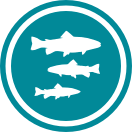
About the Species

American plaice is a species of flounder that is found in relatively deep water from southern Labrador to Rhode Island. It is a popular seafood managed with other groundfish as part of the Northeast multispecies groundfish complex.

Population
The stock is not overfished.

Fishing Rate
Not subject to overfishing.

Habitat Impact
Area closures and gear restrictions protect habitats that are affected by some kinds of trawl gear.

Bycatch
Regulations are in place to minimize bycatch.
Population Status
American plaice is not overfished, not subject to overfishing, and has rebuilt to the target population level (2022 stock assessment). Summary stock assessment information can be found on Stock SMART.
Appearance
American plaice is a right-eyed species of flounder. Plaice have a large mouth, rounded tail, and nearly straight lateral line running lengthwise along their body. The upper side (eyed side) of adult plaice is typically reddish-brown in color, while the underside is white.
Biology
American plaice can live for more than 20 years. Plaice spawn and fertilize their eggs near the ocean bottom. Fertilized eggs float and ultimately hatch near the ocean’s surface. When plaice first hatch, their eyes are symmetrical, with an eye on each side of their head. As the fish grows, it flattens out and the left eye moves over to the right side of its head. After this metamorphosis, the juvenile settles to the ocean bottom. Larval plaice mostly eat plankton and adults primarily feed on bottom-dwelling invertebrates, such as brittle stars, sand dollars, polychaete worms, shrimps, and bivalve mollusks.
Where They Live
Range
American plaice are distributed along the continental shelves from southern Labrador to Rhode Island in relatively deep water.
In the Northwest Atlantic, plaice are found along the Atlantic Coast of North America throughout the Gulf of Maine and Georges Bank.
Habitat
American plaice are relatively sedentary. They are distributed throughout the Gulf of Maine and Georges Bank, and they can also be found in bays and estuaries in Maine and Massachusetts.
American plaice live on the ocean bottom in areas covered by sand, mud, or fine gravel. They are found in relatively deep waters between 130 and 980 feet deep. Juvenile American plaice occupy shallower areas than adults, and are typically found in waters between 130 and 590 feet deep.
Fishery Management
NOAA Fisheries and the New England Fishery Management Council manage the American plaice fishery.
American plaice, along with other groundfish in New England waters, is managed under the Northeast Multispecies Fishery Management Plan, which includes:
- Permitting requirements for commercial vessels.
- Separate management measures for recreational vessels.
- Time/Area closures to protect spawning fish and habitat.
- Minimum fish sizes to prevent harvest of juvenile fish.
- Annual catch limits, based on best available science.
- An optional sector (catch share) program can be used for American plaice and other groundfish species. The sector program allows fishermen to form harvesting cooperatives and work together to decide when, where, and how they harvest fish.
A rebuilding plan was put in place in 2004 and the stock rebuilt in 2019.
Harvest
Commercial Fishery for American Plaice
In 2022, commercial landings of American plaice totaled 1.5 million pounds, and were valued at $2.5 million, according to the NOAA Fisheries commercial fishing landings database.
Gear Types, Habitat Impacts, and Bycatch
American plaice are commonly harvested using trawl nets and, to a lesser extent, gillnets.
Areas closures and gear restrictions reduce habitat impacts from trawl nets. Fishermen follow management measures designed to reduce interactions with marine mammals, including gear modifications, seasonal closures, and use of marine mammal deterrents.
Recreational Fishery for American Plaice
American plaice are not commonly encountered by the recreational fishery. Regulations include a minimum fish size.
Scientific Classification
American plaice are distributed along the continental shelves from southern Labrador to Rhode Island in relatively deep water.
In the Northwest Atlantic, plaice are found along the Atlantic Coast of North America throughout the Gulf of Maine and Georges Bank.
American plaice are relatively sedentary. They are distributed throughout the Gulf of Maine and Georges Bank, and they can also be found in bays and estuaries in Maine and Massachusetts.
American plaice live on the ocean bottom in areas covered by sand, mud, or fine gravel. They are found in relatively deep waters between 130 and 980 feet deep. Juvenile American plaice occupy shallower areas than adults, and are typically found in waters between 130 and 590 feet deep.
Fishery Management
NOAA Fisheries and the New England Fishery Management Council manage the American plaice fishery.
American plaice, along with other groundfish in New England waters, is managed under the Northeast Multispecies Fishery Management Plan, which includes:
- Permitting requirements for commercial vessels.
- Separate management measures for recreational vessels.
- Time/Area closures to protect spawning fish and habitat.
- Minimum fish sizes to prevent harvest of juvenile fish.
- Annual catch limits, based on best available science.
- An optional sector (catch share) program can be used for American plaice and other groundfish species. The sector program allows fishermen to form harvesting cooperatives and work together to decide when, where, and how they harvest fish.
A rebuilding plan was put in place in 2004 and the stock rebuilt in 2019.
Harvest
Commercial Fishery for American Plaice
In 2022, commercial landings of American plaice totaled 1.5 million pounds, and were valued at $2.5 million, according to the NOAA Fisheries commercial fishing landings database.
Gear Types, Habitat Impacts, and Bycatch
American plaice are commonly harvested using trawl nets and, to a lesser extent, gillnets.
Areas closures and gear restrictions reduce habitat impacts from trawl nets. Fishermen follow management measures designed to reduce interactions with marine mammals, including gear modifications, seasonal closures, and use of marine mammal deterrents.
Recreational Fishery for American Plaice
American plaice are not commonly encountered by the recreational fishery. Regulations include a minimum fish size.
Scientific Classification
| Kingdom | Animalia | Phylum | Chordata | Class | Actinopterygii | Order | Pleuronectiformes | Family | Pleuronectidae | Genus | Hippoglossoides | Species | platessoides |
|---|
Last updated by NOAA Fisheries on 03/21/2025
Featured News
 The NOAA research vessel Gloria Michelle conducts groundfish surveys in New England, an important mission to support science-based fisheries management. Photo credit: NOAA Fisheries
The NOAA research vessel Gloria Michelle conducts groundfish surveys in New England, an important mission to support science-based fisheries management. Photo credit: NOAA Fisheries
As Fishing Season Opens, NOAA Implements Emergency Action to Ensure Uninterrupted Northeast Fisheries
 Caption: Yellowtail flounder on a sandy bottom photographed by a towed sampling array called HabCam. Photo Courtesy Woods Hole Oceanographic Institution
Caption: Yellowtail flounder on a sandy bottom photographed by a towed sampling array called HabCam. Photo Courtesy Woods Hole Oceanographic Institution
Ocean Models Help Link Environmental Conditions to a Fishery Stock Assessment

Scientific Trawl Gear Performance Better Understood Thanks to Collaborative Research

2019 Net Spread Study Targets Flatfish, Reveals Subtle Differences
Seafood Facts

U.S. wild-caught American plaice is a smart seafood choice because it is sustainably managed and responsibly harvested under U.S. regulations.
Availability
Year-round.
Source
Wild-caught from Maine to Rhode Island.
Taste
Subtle, sweet flavor.
Texture
Lean and flaky.
Color
Raw American plaice ranges in color from white to pinkish to tan. Cooked flounder is pure white.
Health Benefits
American plaice is a good low-fat source of B vitamins and miacin.
Nutrition Facts
Servings: 1; Serving Weight: 100 g (raw); Calories: 91; Protein: 18.84 g; Total Fat: 1.19 g; Total Saturated Fatty Acids: 0.283 g ; Carbohydrate: 0 g; Total Sugars: 0 g; Total Dietary Fiber: 0 g; Cholesterol: 48 mg; Selenium: 32.7 mcg; Sodium: 81 mgMore Information
Flounder Recipes
Looking for some ways to add flounder into your rotation? If you need some cooking inspiration, browse these recipes for baked flounder with herbs, stuffed flounder, and more!

Last updated by NOAA Fisheries on 03/21/2025
Seafood News
 Fresh-caught taʻape on ice. Credit: Conservation International Hawaiʻi.
Fresh-caught taʻape on ice. Credit: Conservation International Hawaiʻi.
Reducing Waste and Feeding Communities in Hawaiʻi with a Whole Fish Approach
 Chef Tyler Hadfield’s Curried Skate Wings with Tomato-Masala Chutney
Chef Tyler Hadfield’s Curried Skate Wings with Tomato-Masala Chutney
Ring In the New Year With These Crowd-Favorite Seafood Recipes
 NOAA Fisheries, in collaboration with Blue Ocean Mariculture, is conducting a multi-year pilot study to evaluate observational methods and tools for studying Hawaiian monk seal behavior. Courtesy of Blue Ocean Mariculture
NOAA Fisheries, in collaboration with Blue Ocean Mariculture, is conducting a multi-year pilot study to evaluate observational methods and tools for studying Hawaiian monk seal behavior. Courtesy of Blue Ocean Mariculture
AI Meets Aquaculture to Study Hawaiian Monk Seal Interactions With Net Pens
 Tonya Wick aboard a fishing vessel at sea in 1998. Photo courtesy of Tonya Wick
Tonya Wick aboard a fishing vessel at sea in 1998. Photo courtesy of Tonya Wick
Management Overview
American plaice is managed under the Northeast Multispecies (Groundfish) Fishery Management Plan along with 12 other species of groundfish. Collectively, these 13 species are referred to as the Northeast multispecies complex.
More Information
Last updated by NOAA Fisheries on 03/21/2025
Science Overview
Every year, our Northeast Fisheries Science Center compiles valuable information from more than 600,000 species of fish, shark, and invertebrates collected by fishermen, scientists, and observers. This information gives scientists a detailed picture of the overall condition and health of northeast fisheries to ensure sustainable management.
For detailed information about stock status, management, assessments, and resource trends, you can search for American plaice, and any other species of interest, using NOAA’s StockSMART web tool.
Last updated by NOAA Fisheries on 03/21/2025
Research
Ecosystem and Socioeconomic Profile Development and Reports
Status of Ecosystem and Socioeconomic Profiles for Northeast fishery stock assessments.
Last updated by NOAA Fisheries on 03/21/2025





